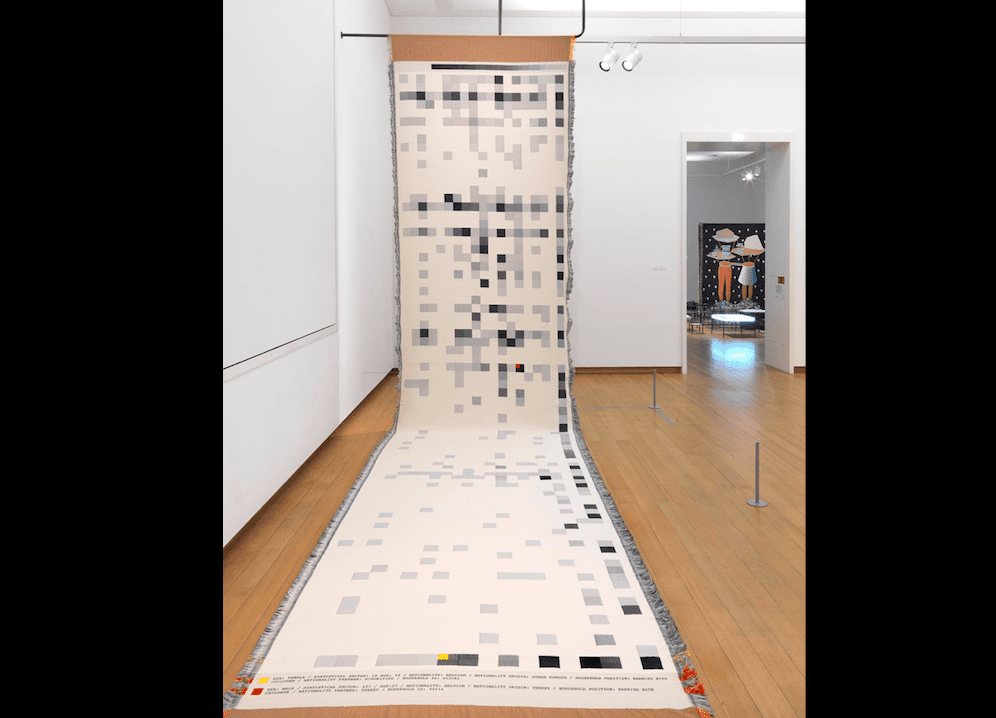Stedelijk Studies, Amsterdam, Netherlands
Deadline: 01 March 2022

Design by Rossella Biscotti, executed by Textiellab Tilburg, 10 x 10 (Acquired Nationality), 2014. Stedelijk Museum Amsterdam, object no. 2015.1.0418(1-2).
The “Diaspora” describes mass movements of displaced peoples, or the scattering of a people away from their geographical “origin”, while objects and ideas have their own flow and transport, displayed through conventions of the elsewhere, usually “the West”.
Diasporic frameworks are part of the decolonializing and postcolonial constellations within contemporary art discourse, and international exhibitions have begun to set broader contours of the Diaspora that resist historically imperialist narratives. Yet, the practices, policies, and strategies around responsibility for the “Collection” of these objects in this framework is still forming on the institutional level. The Call for Research for issue #12 of the Stedelijk Studies Journal seeks approaches, ideas, and experimental projects that align with the broad scope of the Diaspora as a framework for the critical examination of museum collection strategies.
The main interested is in how the Diasporic frameworks are a possible foundation for collection policies based on kinship building and strengthening cultural affiliations, as well as how movement and relocation can be applied to a collection’s display and mediation. Further, the issue concerns the histories of peoples and objects, and the speculative possibilities for museums that grapple with the responsibility of being cultural mediators today.
Stedelijk Museum Amsterdam is currently taking steps in rethinking its acquisition and exhibition strategies. The first step it has taken is to reconsider its collection of over 100,000 pieces into two spheres. The first comprises works that belong to the long twentieth century in which modernism was central—a collection that the museum acknowledges as its foundation and raison d’être. Many of the works that are considered to belong to the “diverse” part of the collection, are made by artists within the worldwide European Diaspora—which can be seen as a regionalist repatriation and continuation of the Western canon of modern art.
The second sphere is concerned with recently acquired works and is motivated by emigrational movements, postcolonial constellations, and community engagement. By breaking away from the modernist acquisition strategies that formed the core of the Stedelijk’s foundational collection, the museum can now examine how plural Diasporas can incorporate the complexities of objects and people. As custodians of the collection, we are obligated to care for it, now and for future generations, which means building in-roads for multiple heritages. While maintaining its steadfast recognition of the past as a source of (un)learning, the collection is then allowed a more open future as we are guided by deep research, critique, and care.
The call understands that “Diaspora” does not undo the logic of coloniality and modernity and could even be interpreted as reinscribing these systems. However, as our current period suggests, global movements are diverse and multiple, and the Stedelijk Studies Journal #12 seeks out those complex connections between all agents, both animate and inanimate. While we are interested in the prospects that emerge from Diasporic acquisition strategies, we also understand systems are persistent and we will take extra care in considering contexts, and to give historical and speculative models equal weight.
Subjects to be considered in relation to Diaspora include and are not limited to:
ABOUT STEDELIJK STUDIES
Stedelijk Studies is a high-quality, peer-reviewed academic journal published by the Stedelijk Museum Amsterdam. The journal comprises research related to the Stedelijk collection, exploring institutional history, museum studies (e.g., education and conservation practice), and current topics in the field of visual arts and design.
PROCESS
To work toward an environment in which intellectual and artistic labor are equally valued, Stedelijk Studies Journal has made it part of its process to incorporate peer-reviewed artistic practices. Consequently, unlike Stedelijk Studies Journal’s previous calls for written papers, this “Call for Research” welcomes knowledge transmissions in all its forms: from academic writing to the full range of artistic media. The issue editors seek contributions that add thoroughly researched, idiosyncratic perspectives to current debates, particularly those that leap into the speculative.
All accepted submissions are subject to scholarly or artistic peer review, and all contributors must be open to receive such feedback and work collaboratively toward a final version.
In order to open up the peer-reviewed process further we will compensate published submissions with a symbolic fee of 400 EUR (excl. VAT).
SUBMISSION
The deadline for the abstract or artwork proposal (max. 300 words and optionally max. 5 images) and CV (merged in one PDF file) is March 1, 2022
The deadline for the written article (4,000–5,000 words) or unwritten contribution (form to be discussed with the issue editors after acceptance) is June 7, 2022.
The issue will be published in December 2022.
Please send abstracts, proposals, and other editorial correspondence to Meredith North, managing editor: stedelijkstudies@stedelijk.nl